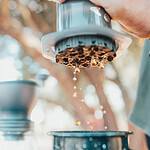Affiliate disclosure: We are reader-supported. This means that we may earn a commission if you buy an item using one of the links. For our reviews, we purchase products ourselves and review them independently. Read more about our methodology.
Summary of Differences
Both AeroPress and Chemex are popular coffee makers for good reason – they both make great-tasting coffee. The most significant difference in our opinion is the taste profile, so which one you buy will come down to how you prefer your coffee.
| AeroPress | Chemex | |
|---|---|---|
| Prices | $40, $50, or $80 | $38 to $161 |
| Supplies needed | Paper or reusable filter | Paper or reusable filter |
| Grind size | Fine to extra fine | Medium-coarse |
| Sizes offered | Single-cup to four-cup | Single-cup to thirteen-cup |
| Materials | BPA-free plastic and rubber | Borosilicate glass; some models also feature a wood and leather handle |
| Great for… |
|
|
How are Chemex and AeroPress Different?
Chemex and AeroPress are two wildly popular coffee makers. However, they are different in how they brew coffee and the flavors they create.
Chemex is a pour-over style coffee maker. With pour-over coffee makers, you pour hot water over coffee grounds sitting in a filter. You usually do one initial pour to let the coffee “bloom.” Blooming allows gases to escape and improves the taste profile. After the initial pour, you pour water in a back-and-forth or circular motion over the grounds, making sure to soak all the coffee grounds. The water flows through the coffee grounds and the filter into the carafe of the Chemex, giving you coffee.
The AeroPress uses a combination of press, immersion, and aeration to brew coffee. You add coffee grounds into the AeroPress and then add hot water. You stir the coffee grounds and water together for 10 to 20 seconds. You push the plunger into the AeroPress to force the water through the coffee grounds and the filter into your cup or carafe. Pushing the plunger down is similar to how a French press works.
No products found.
Taste
Chemex and AeroPress offer distinct taste profiles. The AeroPress is known for the rich and full-bodied flavor it produces. It can make espresso-style drinks with ease. If you love bold-tasting coffee, this is the coffee maker for you.
The Chemex, on the other hand, gives coffee a smooth, crisp, and light flavor. While I own both coffee makers, I gravitate towards the Chemex more because I prefer my coffee to be crisp and smooth.
Ease of Use
Both coffee makers are easy to start using, but I’d argue they require some practice to master.
For pour-over coffee makers like Chemex, there’s an art to how you pour the water over the coffee grounds. You want to thoroughly saturate the coffee grounds with water and time your pours. It helps to have a gooseneck kettle and a timer to achieve this.
You should experiment with brew time and grind size in your AeroPress to find what works best. AeroPress generally takes a fine grind, but a slightly finer or coarser grind may work better for you. Some folks even prefer using the inverted method to brew in the AeroPress.
Alternative Uses
There are some differences between other uses of the Chemex and the AeroPress.
Let’s talk first about all the uses of an AeroPress. Not only can you make coffee in an AeroPress, but you can also make espresso-style drinks, cold brew, and tea. The brewing method for cold brew and espresso style is the same as for coffee, but the time and temperature vary. If you want to make tea in an AeroPress, use the inverted method (we outline that in our AeroPress brew guide).
Because of its design, the AeroPress is also a portable coffee maker. You can easily pack it in your luggage for your next vacation or take it camping. AeroPress designed a special model called the AeroPress Go for traveling and camping. It even comes with a mug for greater portability.
No products found.
You can also use a Chemex to make cold brew and espresso-style drinks. You must adjust the grind size, brewing time, and water temperature. I would not recommend making tea using a Chemex. While it is possible, you use more leaves than you would making your tea the usual way (in my opinion, it’s a waste of tea leaves).
Because a Chemex is made of glass, it’s not ideal for traveling or camping. However, you can actually store and reheat coffee in a Chemex. You can place a Chemex directly on a gas or glass stovetop on low heat to reheat coffee (you shouldn’t place it directly on an electric coil stovetop).
Cleaning
Both AeroPress and Chemex are a breeze to clean. With Chemex, dispose of the coffee grounds and paper filter. If you use a reusable filter, handwash it with warm, soapy water. You don’t need to scrub the inside of the Chemex every day. Swirling soapy water in it is enough for day-to-day cleaning. Depending on how often you make coffee, wash the Chemex by hand every few days to once a week.
After using the AeroPress, unscrew the filter cap and push the coffee grounds into the trash can. Throw out the paper filter. Rinse off the filter cap and the end of the plunger. If you have a reusable filter, rinse that off too. The plunger squeegees the inside of the AeroPress, so there’s no need to clean the inside of the AeroPress.
AeroPress recommends occasionally removing the rubber end from the plunger and handwashing it. Cleaning it helps preserve the life of the plunger.
Cost
Chemex Prices
For the classic Chemex series, the price ranges from $44 to $53. Higher-end models like the glass handle and handblown series range in price from $44 to $161. The classic and glass handle series come in three-cup, six-cup, eight-cup, and ten-cup sizes. The handblown series comes in three-cup, five-cup, eight-cup, and thirteen-cup sizes.
Chemex makes a single-serve model called Funnex. It retails for $38. If you want an electric pour-over machine, Chemex makes the Ottomatic, which costs $350.
With Chemex, you’ll need paper filters or a reusable filter. Chemex only sells paper filters. You can buy filters in a pack of 100 for $11 (or $0.11 per filter). Reusable filters range in price from $8 to $40, depending on the brand and the materials.
AeroPress Prices
AeroPress makes two sizes: the regular size and the XL size. The standard size comes in two models: the original AeroPress and the AeroPress Go, which is travel-friendly. The standard-sized AeroPress retails for $40 or $50, depending on the model and material. The XL version retails for $80.
The standard-sized AeroPress makes either one cup of coffee or three espresso-sized servings. The extra-large size makes four cups of coffee or roughly 12 espresso-sized servings.
Similarly to Chemex, AeroPress requires filters to use. You can purchase paper filters or a reusable stainless steel filter on the AeroPress website. The paper filters range in price from $0.02 to $0.05 depending on how many you purchase and which size you’re getting.
AeroPress sells a reusable stainless steel filter for $15. The reusable filter is not compatible with the XL size.
Price Comparison
Putting all this information together, let’s compare the cost of the XL AeroPress to a three-cup classic Chemex and a six-cup classic Chemex. The three-cup Chemex is slightly smaller than the XL AeroPress – it has a 16-ounce capacity vs. AeroPress XL’s 20-ounce capacity. The six-cup Chemex is significantly larger, holding 30 ounces.
| Cost | Cost of 200 filters | Total cost | |
|---|---|---|---|
| Three-cup classic Chemex | $44.15 | $22.00 | $66.15 |
| Six-cup classic Chemex | $49.50 | $22.00 | $71.50 |
| AeroPress XL (four-cup) | $79.95 | $9.95 | $89.90 |
Despite the higher filter cost, purchasing either size of the Chemex is cheaper than buying the AeroPress XL.
Which One Do We Prefer?
Unsurprisingly, we own both coffee makers at home. When I make coffee for myself (and I’m not reviewing a coffee maker), I use our espresso machine to make a cappuccino.
On the days when I feel like regular coffee, I’m more likely to reach for our Chemex than our AeroPress. And that’s because I prefer the taste profile of the Chemex over the AeroPress. I love when my coffee is mellow, smooth, and clean.
The AeroPress makes a good base for making cappuccinos, lattes, or other milk-based drinks. However, I don’t use it at home since I have an automatic espresso machine. That said, it is perfect to use when traveling.
I particularly love using AeroPress to make cold brew. Similar to the Chemex, it creates a mellow and supple flavor. It’s also a fast way to make a cold-brew-style drink – it only takes about three to five minutes. Most other methods for making cold brew take several hours or an overnight shift in the fridge.


